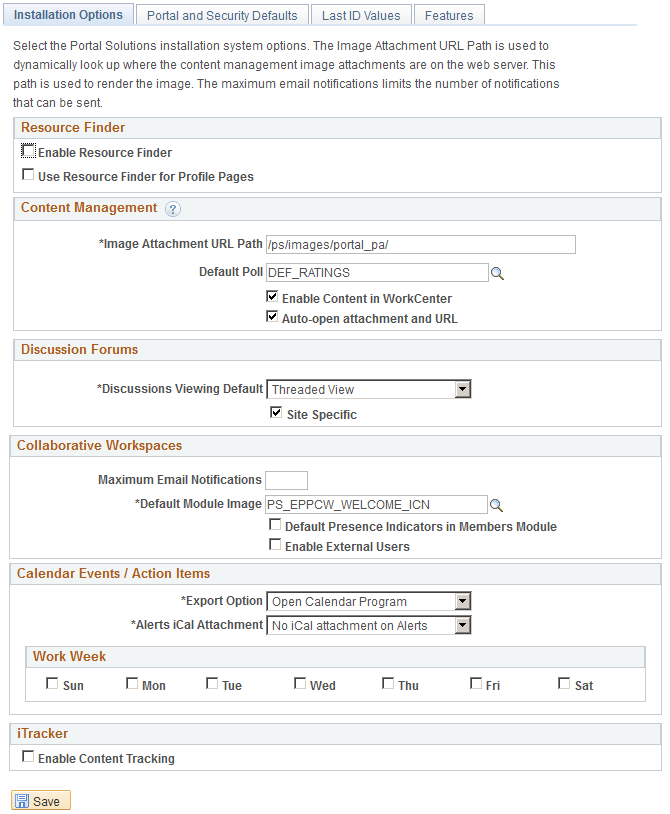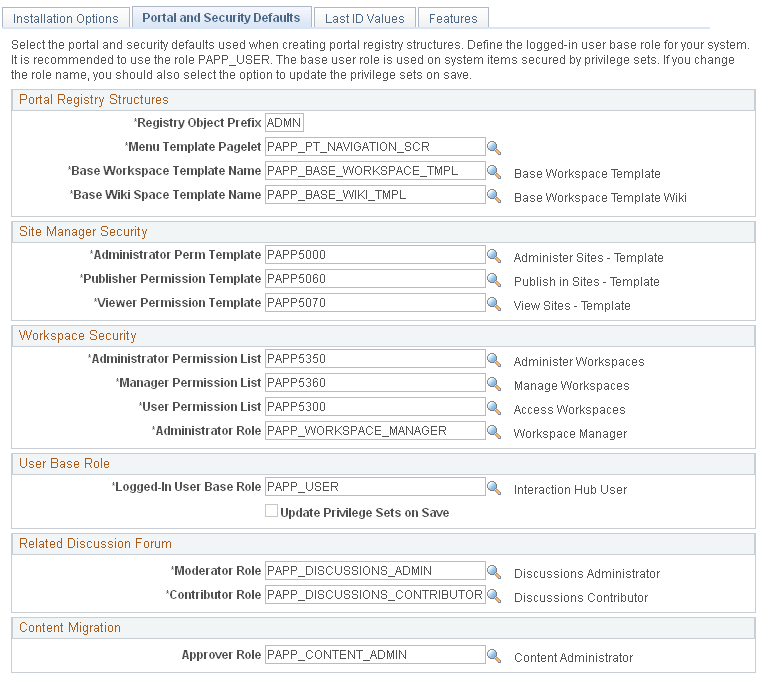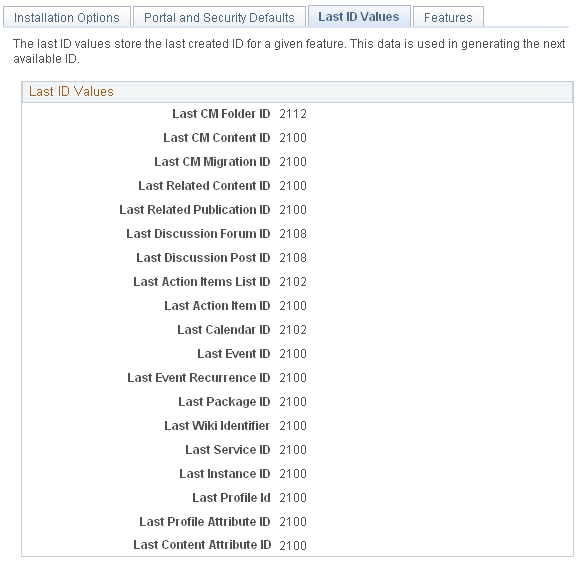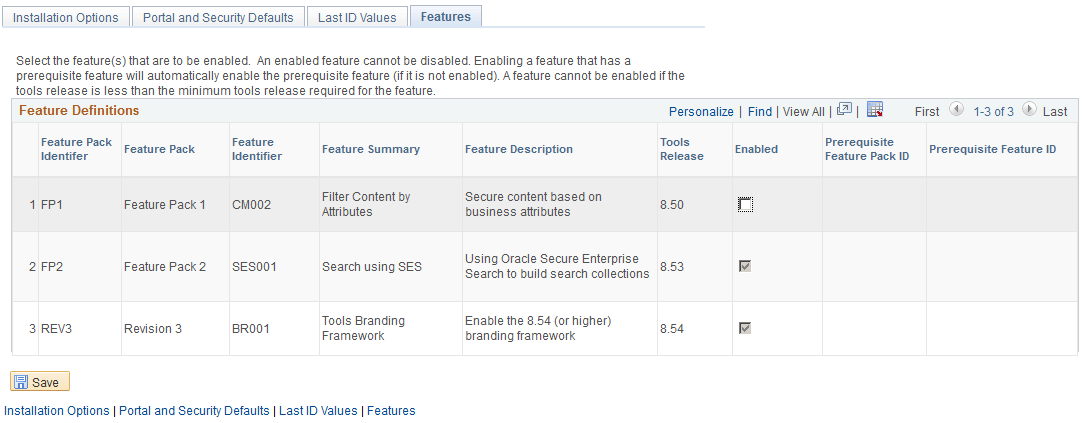Defining Installation Options
This section discusses how to define PeopleSoft Interaction Hub installation options in the Installation Options component (EO_PE_OPTIONS).
|
Page Name |
Definition Name |
Usage |
|---|---|---|
|
EO_PE_OPTIONS1 |
Define PeopleSoft Interaction Hub installation options. |
|
|
EO_PE_OPTIONS2 |
Select the portal and security defaults used when creating portal registry structures. |
|
|
EO_PE_OPTIONS3 |
Displays the last ID created for a given feature. This data is used in generating the next available ID. |
|
|
EO_PE_OPTIONS4 |
Enable specific features delivered in revisions (formerly known as feature packs). |
Use the Installation Options page (EO_PE_OPTIONS1) to define PeopleSoft Interaction Hub installation options.
Navigation:
This example illustrates the fields and controls on the Installation Options page. You can find definitions for the fields and controls later on this page.

Use the Installation Options page to configure your installation of PeopleSoft Interaction Hub.
Resource Finder
Field or Control |
Description |
|---|---|
Enable Resource Finder |
Select to use the Resource Finder feature. It is not selected by default. |
Use Resource Finder for Profile Pages |
Select to use Resource Finder participant profiles as the source for participant information for Collaborative Workspaces and Content Management. In Collaborative Workspaces, these Resource Finder participant profiles will be used as the source for member profiles accessible from the Members module. When a user clicks a member name link in the Members module, the member profile that appears will be based on the member's Resource Finder participant profile. In Content Management, these Resource Finder participant profiles will be used as the source for user profiles accessible by clicking user name links in the components. For example, fields such as Created By, Checked Out By, and so forth will contain user name links. For this option to work as designed, you must have the following setup in place:
If you leave this option blank, when a user clicks a member name link in the Members module, the member profile that appears will be based on information from these tables: PSOPRDEFN, PSUSEREMAIL, EPPCW_MEMBERS, and PS_EPPRC_IM_USERVW. See Member Profile Page. |
Content Management
Field or Control |
Description |
|---|---|
Image Attachment URL Path |
Enter the web server’s relative or absolute URL of the extended path that will contain the image files from the FTP server. The choice of URLs is based on the information from the URL Maintenance page that is found in the menu path, for the URL ID EPPCM_IMAGE. |
Default Poll |
Select ID for the default ratings poll. This poll is used to rate pieces of content and is made available in the Related Content frame of the WorkCenter template. |
Enable Content in WorkCenter |
Select this option to enable viewing of content in the WorkCenter template. |
Discussion Forums
Field or Control |
Description |
|---|---|
Discussions Viewing Default |
Select Flat View to display all discussion postings in chronological order with details. Select Threaded View to display the hierarchy of the discussion without the details. |
Site Specific |
Select to make a discussion forum viewable only within the site in which it was created. For example, if Site Specific is selected and a user is in the Customer portal, then in the Discussions pagelet, that user will see discussion forums that were created in the Customer portal only. Deselect this option to make all discussion forums appear regardless of the portal in which it was created. For example, if the user is in the Customer portal, then in the Discussions pagelet the user will see discussion forums created in the Customer portal, Employee portal, Supplier portal, and so on. |
Collaborative Workspaces
Field or Control |
Description |
|---|---|
Maximum Email Notifications |
Enter the maximum number of email messages you want to be able to send in the member invitation notification process for a Collaborative Workspace. If the number of email messages sent in the notification process exceeds this number, an error appears and the system sends no email. |
Default Module Image |
Enter the name of the image that you want to display by default in the Collaborative Workspace menu to the left of module names. |
Default Presence Indicators in Members Module |
Select to display instant messaging presence indicators in the Members module. If you decide to display presence indicators, keep in mind that one server trip is executed per indicator per member. See Understanding Instant Messaging in PeopleSoft Interaction Hub. |
Enable External Users |
Select this option to enable workspace owners to invite external users to participate in the workspace. |
Calendar Events / Action Items
Field or Control |
Description |
|---|---|
Export Option |
Select the option for the Export link on the Event View page and the Add to Personal Calendar link on the Action Item Details page. Valid options are
|
Alerts iCal Attachment |
Select settings for iCal attachments and for event alert notification email messages. Valid options are:
|
Field or Control |
Description |
|---|---|
Work Week |
Select days to define the default work week for all calendars in the system. These defaults can be overridden by the properties of each calendar. |
iTracker
Field or Control |
Description |
|---|---|
Enable Content Tracking |
Select this option to enable automatic invisible usage tracking (iTracker) for content management system content, discussion forum posts, and blog posts. |
Use the Portal and Security Defaults page (EO_PE_OPTIONS2) to select the portal and security defaults used when creating portal registry structures.
Navigation:
This example illustrates the fields and controls on the Portal and Security Defaults page. You can find definitions for the fields and controls later on this page.

Select the portal and security defaults for creating portal registry structures and define the user base role for your system.
Since the base user role on system items is secured by privilege sets, PeopleSoft recommends that you use the delivered role PAPP_USER. If you change the role name, you should also select the option to update the privilege sets on save.
Portal Registry Structures
Registry structures are the stored menu items, pagelets, templates, and such. Many features automatically create portal registry structures, including Pagelet Wizard pagelets, News Publication pagelets, Submitted Menu Items, Manage Navigation, and Shortcut Collections.
Field or Control |
Description |
|---|---|
Registry Object Prefix |
Enter a value to use as a prefix for all automatically created portal registry structures. Note: This value allows easy identification of the objects that are in PeopleSoft Application Designer. |
Menu Template Pagelet |
Enter the menu template pagelet value that is to be used when rendering target pages by using Context Manager. Note: PAPP_PT_NAVIGATION_SCR is the delivered default value. If you want to customize and use your own menu template pagelet, enter its value here. |
Base Workspace Template Name |
Select the portal registry template on which all Collaborative Workspace templates and their portal registries are based. |
Base Wiki Space Template Name |
Select the portal registry template on which all Wiki Space templates and their portal registries are based. |
Site Manager Security
The created site uses these permissions to limit access to the navigation and administration of the new site.
Field or Control |
Description |
|---|---|
Administrator Perm List Template (Administrator Permission List Template) |
Enter the administrator template permission lists that are cloned during the creation of a new site. |
Publisher Permission Template |
Enter the publisher template permission lists that are cloned during the creation of a new site. |
Viewer Permission Template |
Enter the viewer template permission lists that are cloned during the creation of a new site. |
Workspace Security
Field or Control |
Description |
|---|---|
Administrator Permission List |
Select the permission list for administrators of the workspace. The delivered permission list is PAPP5350. |
Manager Permission List |
Select the permission list for managers of the workspace. The delivered permission list is PAPP5360. |
User Permission List |
Select the permission list for users of the workspace. The delivered permission list is PAPP5300. |
Administrator Role |
Enables you to select a different role name that is automatically used as the workspace instance portal administrator. This role is granted to users who are listed as workspace managers. |
User Base Role
Field or Control |
Description |
|---|---|
Logged-In User Base Role |
Select the role that enables access to the base objects in the PeopleSoft Interaction Hub features that use privilege sets. The delivered role is PAPP_USER. Every user in the system, other than Guest, must be assigned this role along with the PeopleSoft User role. Note: If you select a role other than PAPP_USER, make sure to select Update Privilege Sets on Save to automatically update the privilege set assignments to the new role. |
Update Privilege Sets on Save |
Select this checkbox to update all privilege set assignments to the base user role when you select Save. This option enables you to change the role name in the privilege set assignment for all the features that have the concept of privilege sets. This enables you to use your own 'base' role instead of the delivered role. So, if you change your base role, it's not a customization. This setting lets you update all the privilege set assignments to your role. We deliver some system data using this role, but some of these privilege set assignments (like for discussions) are not accessible online. |
Related Discussion Forum
Field or Control |
Description |
|---|---|
Moderator Role |
Select a role for the moderator. |
Contributor Role |
Select a role for contributors. |
Content Migration
Field or Control |
Description |
|---|---|
Approver Role |
Select a role for approvers. |
Use the Last ID Values page (EO_PE_OPTIONS3) to displays the last ID created for a given feature.
This data is used in generating the next available ID.
Navigation:
This example illustrates the fields and controls on the Last ID Values page.

The Last ID Values page displays the current greatest value for IDs that are used by other features in PeopleSoft Interaction Hub such as content management, related content, discussion forums, and so on.
Each time a new item is added, the counter is automatically increased by one. This feature eliminates locking issues.
Use the Features page (EO_PE_OPTIONS4) to enable specific features delivered in revisions (formerly known as feature packs).
Navigation:
This example illustrates the fields and controls on the Features page.

Ensure that your system meets the minimum PeopleTools release listed in the Tools Release column. Then select the Enabled option to enable a specific feature.
The currently available features are:
|
Feature Pack |
Feature ID |
Description |
For More Information |
|---|---|---|---|
|
FP1 |
CM002 |
Secure content based on business attributes |
See Administering Content Management Business Attribute Security. |
|
FP2 |
SES001 |
Enable the use of Oracle Secure Enterprise Search to build search collections. |
|
|
REV3 |
BR001 |
Enable the PeopleTools branding framework. |
Not all features delivered in a revision are enabled through this page. Other features delivered in revisions, while not specifically identified as such, can be enabled on the Installation Options page.